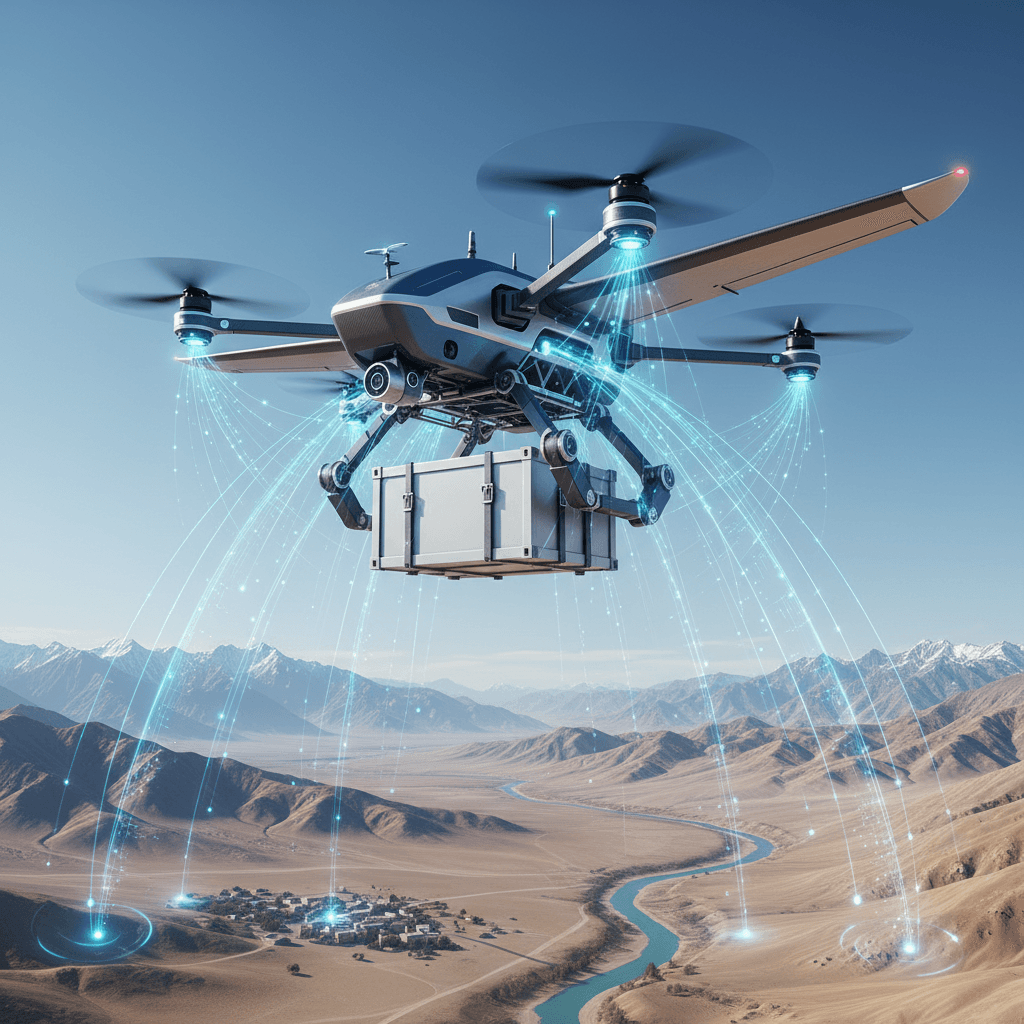BonV Aero's AI Drone Flies India's First 60km Heavy-Lift BVLOS Mission
First Indian firm achieves landmark 60km, 20kg BVLOS drone flight, transforming logistics and national capabilities with AI.
October 16, 2025

In a significant leap for India's unmanned logistics and artificial intelligence sectors, aerospace technology firm BonV Aero has successfully completed a 60-kilometer Beyond Visual Line of Sight (BVLOS) drone mission while carrying a substantial 20-kilogram payload.[1][2] This achievement, a first for an Indian company, signals a new era of autonomous aerial delivery, with profound implications for defense, disaster relief, and commercial connectivity in the nation's most challenging terrains.[1][3][4] The mission, which lasted 75 minutes and maintained an average speed of 48 kilometers per hour, demonstrates the operational maturity of domestically developed drone technology, moving it beyond experimental trials and into the realm of real-world application.[2][3][4] This breakthrough is not merely a logistical success but a showcase of the sophisticated AI and autonomous systems that are becoming the backbone of modern aerial mobility.
The 60km flight represents a critical convergence of range and payload capacity, a combination that has been a long-sought goal in the drone logistics industry.[3][5] Successfully operating an unmanned aerial vehicle (UAV) beyond the pilot's direct eyesight requires a complex interplay of advanced software, sensor technology, and reliable hardware. BonV Aero's success is attributed to its proprietary propulsion and energy systems, which have been specifically engineered for high-endurance and heavy-lift applications.[1][4] Co-founder and CEO Satyabrata Satapathy described the event as a "defining moment for Indian drone logistics," emphasizing that it is the first time a domestic UAV has proven this level of capability in a single BVLOS flight.[1][5] This achievement validates the company’s focus on creating solutions for India’s toughest geographies, where conventional infrastructure is lacking and traditional air transport like helicopters can be prohibitively expensive or risky.[1][5] The ability to transport a 20kg payload—enough for critical medical supplies, emergency equipment, or high-value commercial goods—over such a distance opens up a viable new channel for supply chain and emergency response networks.
This recent milestone builds upon BonV Aero's previously established reputation for pushing the boundaries of drone performance in extreme environments. In 2023, the company entered the International Book of Records for a high-altitude flight at Umling La Pass in Ladakh.[6][7] In that remarkable test, its UAV lifted a 30-kilogram payload to an altitude of 19,024 feet, the world's highest motorable pass.[1][6][7] This feat was significant as it demonstrated the drone's ability to operate in thin air and harsh conditions where conventional rotary aircraft face severe payload limitations; for instance, a Cheetah helicopter can lift only around 20kg under similar conditions.[6][8][9] That world record was a testament to the robustness of the company’s engineering and its collaboration with the Indian Army to address logistical challenges in high-altitude areas.[10][8] Together, these two achievements—mastering both extreme altitude with heavy loads and long-distance BVLOS operations—position the company as a leader in developing versatile and resilient unmanned aerial systems capable of performing critical missions reliably and repeatedly.
The success of such advanced drone operations is intrinsically linked to the growing sophistication of artificial intelligence. For a drone to navigate a 60-kilometer path without a human pilot's direct visual guidance, it relies heavily on AI-driven autonomous systems.[11] These systems process data from a suite of sensors to manage navigation, maintain flight stability, optimize power consumption, and ensure safe passage through complex airspace. The AI algorithms are responsible for real-time decision-making, a task that is critical for the safety and success of any BVLOS mission. Furthermore, the development of a scalable drone logistics network hinges on the implementation of an Unmanned Aircraft System Traffic Management (UTM) framework, another area where AI is indispensable.[12][13] A UTM system will be required to manage potentially thousands of autonomous drones, deconflicting flight paths, ensuring regulatory compliance, and integrating with traditional air traffic control. The data and operational parameters from flights like BonV Aero's are crucial for building and refining the AI models that will power these future UTM systems, thus paving the way for wider adoption.
The implications of this achievement extend across both the public and private sectors, promising to revolutionize logistics and enhance national capabilities. For the Indian armed forces, this technology offers a reliable method for battlefield resupply and intelligence, surveillance, and reconnaissance (ISR) missions, especially in contested or difficult-to-reach border areas, reducing the risk to human personnel.[1][14] In the civilian domain, the potential is equally transformative. During natural disasters, these drones can be deployed as first responders to deliver life-saving supplies to cut-off communities.[4][15] For commerce, it unlocks the potential for last-mile delivery to remote villages and towns, connecting them to the broader economy for everything from e-commerce goods to critical healthcare products like vaccines.[5][16][17] While regulatory frameworks for routine commercial BVLOS flights are still evolving in India, this successful mission provides a powerful proof-of-concept that is likely to accelerate policy development and encourage further investment in the nation's burgeoning drone ecosystem.[18][16]
In conclusion, BonV Aero's 60-kilometer, 20-kilogram payload mission is a landmark event that pushes the boundaries of unmanned aerial logistics in India. It serves as a powerful demonstration of indigenous technological capability, showcasing a platform that is robust, reliable, and ready for complex, real-world challenges. More importantly, it highlights the critical role of artificial intelligence in enabling the next generation of autonomous systems. As India continues to pursue its ambition of becoming a global drone hub, achievements like this are crucial stepping stones, building confidence among regulators, industry, and the public.[16] This flight does more than just transport a payload; it carries the promise of a future where autonomous, AI-powered drones can overcome geographical barriers, save lives, and create new economic opportunities across the subcontinent.
Sources
[4]
[5]
[6]
[10]
[11]
[12]
[13]
[16]
[17]
[18]